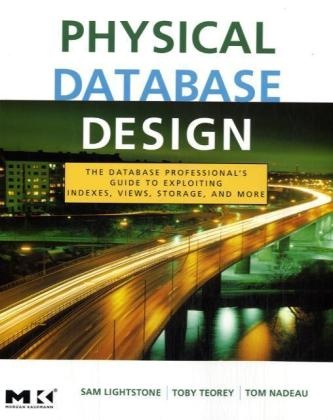Read more
Informationen zum Autor Sam Lightstone is a Senior Technical Staff Member and Development Manager with IBM's DB2 product development team. His work includes numerous topics in autonomic computing and relational database management systems. He is cofounder and leader of DB2's autonomic computing R&D effort. He is Chair of the IEEE Data Engineering Workgroup on Self Managing Database Systems and a member of the IEEE Computer Society Task Force on Autonomous and Autonomic Computing. In 2003 he was elected to the Canadian Technical Excellence Council! the Canadian affiliate of the IBM Academy of Technology. He is an IBM Master Inventor with over 25 patents and patents pending; he has published widely on autonomic computing for relational database systems. He has been with IBM since 1991. Toby J. Teorey is a professor in the Electrical Engineering and Computer Science Department at the University of Michigan! Ann Arbor. He received his B.S. and M.S. degrees in electrical engineering from the University of Arizona! Tucson! and a Ph.D. in computer sciences from the University of Wisconsin! Madison. He was general chair of the 1981 ACM SIGMOD Conference and program chair for the 1991 Entity-Relationship Conference. Professor Teorey's current research focuses on database design and data warehousing! OLAP! advanced database systems! and performance of computer networks. He is a member of the ACM and the IEEE Computer Society. Tom Nadeau is the founder of Aladdin Software (aladdinsoftware.com) and works in the area of data and text mining. He received his B.S. degree in computer science and M.S. and Ph.D. degrees in electrical engineering and computer science from the University of Michigan! Ann Arbor. His technical interests include data warehousing! OLAP! data mining and machine learning. He won the best paper award at the 2001 IBM CASCON Conference. Klappentext The rapidly increasing volume of information contained in relational databases places a strain on databases! performance! and maintainability! and DBAs are under greater pressure than ever to optimize database structure for system performance and administration.Physical Database Design discusses the concept of how physical structures of databases affect performance and includes specific examples! guidelines! and best and worst practices for a variety of DBMSs and configurations. Something as simple as improving the table index design has a profound impact on performance. Every form of relational database! such as Online Transaction Processing (OLTP)! Enterprise Resource Management (ERP)! Data Mining (DM)! or Management Resource Planning (MRP)! can be improved using these methods.About the Authors:Sam Lightstone is a Senior Technical Staff Member and Development Manager with IBM's DB2 product development team. He is cofounder and leader of DB2's autonomic computing R&D effort. He is Chair of the IEEE Data Engineering Workgroup on Self Managing Database Systems and a member of the IEEE Computer Society Task Force on Autonomous and Autonomic Computing. He is an IBM Master Inventor with over 25 patents and patents pending; he has published widely on autonomic computing for relational database systems.Toby Teorey is a professor emeritus in the Electrical Engineering and Computer Science Department and Director of Academic Programs in the College of Engineering at the University of Michigan! Ann Arbor. He has been active as program chair and program committee member for a variety of database conferences.Tom Nadeau is the founder of Aladdin Software (aladdinsoftware.com) and works in the area of data and text mining. He received M.S. and Ph.D. degrees in electrical engineering and computer science from the University of Michigan! Ann Arbor. His technical interests include data warehousing! OLAP! data mining! and machine learning. He won the best paper award at the 2001 IBM CASCON Conference. Zusammenfassung ...
List of contents
1 Introduction to Physical Database Design
2 Basic Indexing Methods
3 Query Optimization and Plan Selection
4 Selecting Indexes
5 Selecting Materialized Views
6 Shared-nothing Partitioning
7 Range Partitioning
8 Multidimensional Clustering
9 The Interdependence Problem
10 Counting and Data Sampling in Physical Design Exploration
11 Query Execution Plans and Physical Design
12 Automated Physical Database Design
13 Down to the Metal: Server Resources and Topology
14 Physical Design for Decision Support, Warehousing, and OLAP
15 Denormalization
16 Distributed Data Allocation
Appendix A A Simple Performance Model for Databases
Appendix B Technical Comparison of DB2 HADR with Oracle Data Guard for Database Disaster Recovery
Report
"I highly recommend Physical Database Design by Lightstone, Teorey, and Nadeau. The book covers fine aspects of physical design -- issues such as the effects of different approaches to indexes, tradeoffs in materializing views, and details of physical data layout. Unlike other books, it does not focus on a particular product, but instead covers the deep principles that cut across products. The book addresses both transaction intensive applications (OLTP) as well as data warehouses (OLAP). Their new book is a welcome addition to the literature." --Michael Blaha, OMT Associates, Inc.
"This is an excellent book on physical database design, giving pragmatic models and advice. It has a wealth of information for both the student and for the practitioner -- presenting analytic models and practical tips that are demonstrated with examples using Oracle, DB2, and Microsoft SQL Server." --Jim Gray, Microsoft Research

